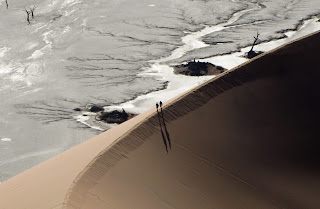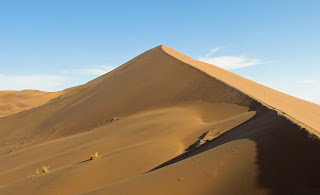The Namib Desert at Sossusvlei
Wednesday, Aug 26th
Our guide Jeremia, who we had met the night before in the hotel and who would be with us for the next nine days, picked us up from the hotel at 6:45 in the morning for the drive back to the international airport. This time we got on a tiny plane, a Cessna 210, which is a 5 seater single engine prop plane. It was rather cramped inside, but fortunately the flight to Sossusvlei took only an hour. We flew towards the South-West over the spectacular landscape of the Naukluft mountains and into the Namib desert. Before driving to camp we quickly stopped by the hot air balloon office, which is right next ot the airport, to try to arrange a balloon ride, which was not part of our organized trip schedule. We were lucky to be able to book the last two spots on the balloon for Friday morning.
Our home for the next three nights, the Kulala Adventurer Camp, is incredibly remote, tucked behind a small mountain with amazing views of the red dunes in the distance. The camp consists of just 6 tents on raised platforms. The tents are a lot more basic than what we had in Hoanib, but they are very comfortable with proper beds and a little bathroom with a shower in the back. We had solar powered hot water and some small lights, but there was no electricity to charge anything, so we had to be a bit careful with not using up camera batteries in the next three days. What made this camp seem even more remote was the fact that we were the only people staying here. There were no other guests, just the two of us with our guide and three staff members in the camp.
We had a very nice lunch and a relaxing afternoon rest before going on a little hike from the camp in the late afternoon. We walked straight out over the huge flat expanse towards the dunes which we were told were about 8 km away. (I found it almost impossible to judge distances in this incredibly vast and empty landscape.) The area here is even dryer and sparser than the Skeleton Coast up in Hoanib, yet it is again filled with a surprising wealth of wildlife. It is hard to imagine how a totally dry and bleak landscape like this can sustain all these large animals. We see several oryxes, a couple of ostriches in the distance and most excitingly two bat eared foxes. The foxes were very hard to see when they crouched down in the brown sand. But when we got a bit closer, they suddenly jumped up and ran away.
Everywhere around here we saw these strange circles in the sand, bare in the center and surrrounded by a few dried out pieces of grass. They are called fairy circles. It is still not a hundred percent established what exactly causes them, although the most likely explanation is termites, which apparently build circular underground structures that cause these patterns above ground. On our way back to camp we witnessed an amazing sunset over the dunes in the distance.
The Namib is a coastal desert. It stretches along the Atlantic ocean coast for over 2,000 km starting in South Africa, along the entire length of Namibia and into Angola. The Namib is generally considered the oldest desert in the world, as it has been in this arid condition for somewhere between 55 and 80 million years. This is an incredible long time, as it means this landscape probably looked not too dissimilar when dinosaurs were walking through it. The Namib is also one of the driest deserts in the world, with some parts receiving less than 2 millimeters of precipitation per year. The climate is very typical for a dry desert with huge temperature swings between day time, when temperature can reach well above 40 degrees, and night time, when they can drop below freezing. The coastal regions are covered in dense fog almost every morning. Many of the plants and animals that survive here get all of their moisture from the fog. The fog has also always been a serious hazard for ships and the numerous shipwrecks gave the Skeleton Coast its name. Many of the animals and plants here are either endemic, or so highly adapted to the desert conditions, that they are almost separate species. Although most of the Namib is now protected area, a few important mining areas remain, with rich deposits of diamonds and tungsten.
Thursday, Aug 27th
Early morning wake up call as usual. Today we drove out to the Naukluft Mountain Park. It was about a two hour drive to get to the entrance of the park. Right after entering the park, we saw a few mountain zebras on the side of the hill. After a short coffee break at the ranger lodge we went on a hike into the mountains. This is a beautiful area, quite different from the desert landscape we had seen so far. There is even water here. We walked along a valley with a little mountain stream, which was the first running water we had seen in Namibia. After little over an hour hiking uphill we ended up at this perfectly clear little pool.
We kept looking out for leopards, but they are very rare and very difficult to see. Jeremia told us that he had only ever seen a leopard once here. On the way down we saw a family of baboons, and then a rock hyrax in the bushes. Rock hyraxes look like little rodents, sort of like a large grey guinea pig. However they aren't rodents. In fact the most interesting thing about them is that they are a separate species, whose closest living relatives are elephants and manatees. (Seriously, I am not making this up.)
On our drive back we stopped at another incredible place, which you would not expect to exist in a place like this - the driest winery in the world. It is called Neuras Winery, which was started in 1996, and though quite small has been thriving ever since. We have a very nice lunch followed by a tour through the vineyard and a wine tasting with very nice local cheese. They currently only produce 3,000 bottles of two types of red wine a year, but they are about to expand to 15,000 bottles. There are several natural springs in the area with allows them to water the vines just enough. I am not a wine expert, but I thought the wines they produced were very good.
Friday, Aug 28th
An even earlier wake up call this morning, since we had to be at the balloon launch site by 6 am. It was still completely dark when we left camp. We watched the balloons being prepared and inflated, before we got into our large 16 person basket.
The flight was absolutely amazing, We were up there for over an hour and had stunning views of the desert and the mountains. It was only the second time that I had been on a hot air balloon, but I will be looking for them at other places from now on. It is such a beautiful way to travel and to get views you would never see in any other way. Since there were three balloons we also got these amazing shots the other balloons with the dunes and mountains in the background.
I also had my GoPro with me and managed to take this time lapse video of our flight:
Because there was not too much wind today, our pilot was able to perform an unbelievable pinpoint landing and put the basket right onto the trailer, so the crew wouldn't have to lift it up there. After the balloon ride they set up the most amazing champagne breakfast in the middle of the desert. One of the pilots opened the first champagne bottle by decapitating it with a machete. The buffet even included smoked zebra.
We drove back to camp for a lunch break and a little rest before departing for the highlight of this part of the trip, the Red Dunes of Sossusvlei.
Sossusvlei, which is part of the Namib-Naukluft National Park (established in 1907), is a salt and clay pan surrounded by some of the largest and most spectacular sand dunes of the Namib desert. The Namib is famous for having the tallest sand dunes in the world, some of which reach over 300 meters in height and are over 30 kilometers long. Apart from their size the most remarkable thing about these dunes is their color, ranging from bright pink to a vivid orange-red. The color is created by iron oxides and garnet minerals in the sand.
The drive into the park took about an hour, which was only briefly interrupted when we saw three baby oryxes lying on the road in front of us.
We drove all the way to the end of the paved road to a massive dune called Big Daddy, which is on of the highest and apparently a hard climb to get to the top. Unfortunately we had less than two hours left before we had to leave the park again, since the park gates closed at sunset. Jeremia thought there was no way that we had enough time to climb Big Daddy, but Shiva, our young driver, and I saw this as a challenge and decided to give it a try.
We left the car park just after 3 pm, knowing that we would have to turn around at 4 to make it back in time. When we got to the start of the Big Daddy climb we only had 35 minutes left, but we pushed very hard. It was quite a difficult climb in the soft sand along the razor sharp ridge, but we made it to the top in 31 minutes. And the amazing views from up there were absolutely worth the effort.


The way down was lot more fun. We could run, slide and jump straight down the steep side of the dune.
We met up with Jeremia and Lara on the bottom in what looked like a dried out lakebed. This salt and clay pan is called Deadvlei. It looks particularly surreal, because of the dead trees here, which are left-overs from a time when this area was an oasis. These dead acacia trees are believed to be over 600 years old, as they don’t decompose because of the extreme dry conditions. This was certainly one of the most amazingly beautiful and most unusual landscapes I had ever seen.
The dunes of the Namib desert received the Unesco World Heritage dedication very recently in 2013. And they also deserve to get a place very high up on my personal list of the Top 25 Natural Wonders of the world.
We just managed to get to the exit gate at sunset, where Jeremia stopped the car and started to unpack wine, beer and dried fruit for our sundowner. Another perfect end to an unbelievable day.
___________________________________________________________________________________________
___________________________________________________________________________________________









































No comments:
Post a Comment